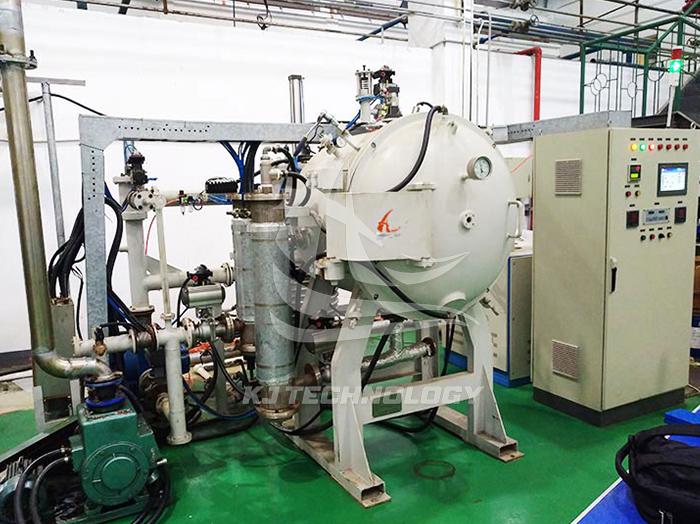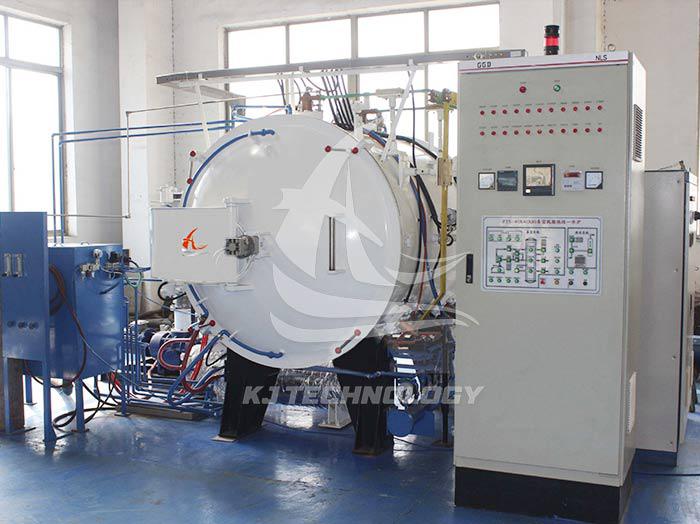Common faults and troubleshooting methods of electric heating vacuum brazing furnace
 04-02-2025 Author: KJ technology
04-02-2025 Author: KJ technology
The electric heating vacuum brazing furnace may encounter various faults during use. The following are some common faults and their troubleshooting methods:
1. Temperature control failure
Fault phenomenon: The temperature cannot be stabilized at the set value, fluctuates greatly, or the displayed temperature does not match the actual temperature.
Possible reasons:
Thermocouple wire breakage, damage, or incorrect installation position.
Temperature control instrument malfunction.
Heating element aging, damage or insufficient power.
Exclusion method:
Replace the thermocouple with a new one and ensure that its installation position is accurate.
Perform maintenance or replacement according to the temperature control instrument manual.
Check the heating element, such as whether the graphite heating tube is contaminated and whether the resistance value has increased. If there is a problem, replace it in a timely manner and ensure that the resistance of the new graphite tube matches the voltage regulator.
2. Unable to reach the maximum vacuum degree or decrease in vacuum degree
Fault phenomenon: inability to reach the maximum vacuum degree or vacuum degree decrease, leakage.
Possible reasons:
The aging, damage, or improper installation of sealing components can lead to furnace leakage.
Vacuum pump malfunction, such as low pumping efficiency, oil contamination, and shaft seal wear.
There are air leakage points in the vacuum system, such as poorly sealed valves and loose pipeline connections.
Exclusion method:
Check and replace aging and damaged seals to ensure proper installation.
Inspect or replace the vacuum pump to eliminate issues such as oil contamination and wear.
Perform leak detection on the vacuum system, identify the leak points and repair them, such as replacing valve seals, tightening pipeline connections, etc.
3. Slow or unable to heat up
Fault symptoms: slow heating, failure to reach rated heating power or inability to heat up.
Possible reasons:
Magnetic regulator malfunction.
The heating element is short circuited or open circuited.
The power supply voltage is unstable or lacks phase.
Exclusion method:
Inspect the magnetic voltage regulator and check for loose wiring and normal contacts.
Check the resistance value of the heating element and replace the short circuited or open circuited heating element.
Use a voltage regulator to stabilize the power supply voltage and check for any phase loss issues in the electrical circuit.
4. Malfunctions in the operation of transmission components
Fault symptoms: The transmission components are not running smoothly, there is abnormal noise, the limit is malfunctioning or unable to reach the predetermined position.
Possible reasons:
Gear wear and poor lubrication.
Motor malfunction.
The limit switch is damaged or improperly adjusted.
Loose coupling or different shafts.
Exclusion method:
Check and replace worn gears, and strengthen lubrication.
Repair or replace faulty motors.
Check and adjust the limit switch to ensure it is functioning properly.
Tighten the coupling to ensure its coaxiality.
5. Thermocouple burned out
Fault phenomenon: Thermocouple burnt out.
Possible reasons:
Thermocouples collide with carbon felt.
Thermocouples are not sealed.
Exclusion method:
Remove obstacles near the vacuum brazing furnace heater to prevent the thermocouple from colliding with the carbon felt.
Check and replace the thermocouple sealing ring to ensure its sealing performance.
6. Vacuum valve switch malfunction
Fault phenomenon: Vacuum valve switch malfunction.
Possible reasons:
The compressed air pressure is insufficient.
Electromagnetic valve malfunction.
Exclusion method:
Ensure that the air pressure is not less than the specified value (such as 0.5MPa).
Inspect the solenoid valve and, if necessary, add rubber pads to tighten it.
7. Mechanical pump malfunction
Fault symptoms: Mechanical pump cannot start, rotation direction is incorrect, operation is not flexible, pumping efficiency is low or vacuum degree cannot be reached.
Possible reasons:
The position of the motor starter switch is incorrect or the overload protection device is triggered.
Motor wiring error.
Internal faults of mechanical pumps, such as oil contamination, shaft seal wear, etc.
Exclusion method:
Check the position of the motor starter switch and overload protection device to ensure their normal operation.
Replace the two-phase wiring in the three-phase motor to ensure correct rotation direction.
Repair the mechanical pump according to the instructions, and replace the oil or shaft seal if necessary.
8. Low insulation resistance
Fault phenomenon: The insulation resistance is lower than the specified value (such as 1000 ohms).
Possible reason: There are carbon fibers or other conductive substances around the electrode.
Exclusion methods: Remove flying copper, oven treatment, clean carbon fiber and other conductive substances.
9. Treating the surface of the parts as not shiny
Fault phenomenon: The surface of the processed parts does not light up.
Possible reasons:
The cooling gas is impure.
The vacuum degree is too low.
Exclusion method:
Ensure that the purity of nitrogen (argon) gas meets the specified requirements (such as 99.9996% or above), and the water and oxygen content is less than the specified values (such as 5ppm).
Check the vacuum system and cooling system of the vacuum brazing furnace to ensure their normal operation.








